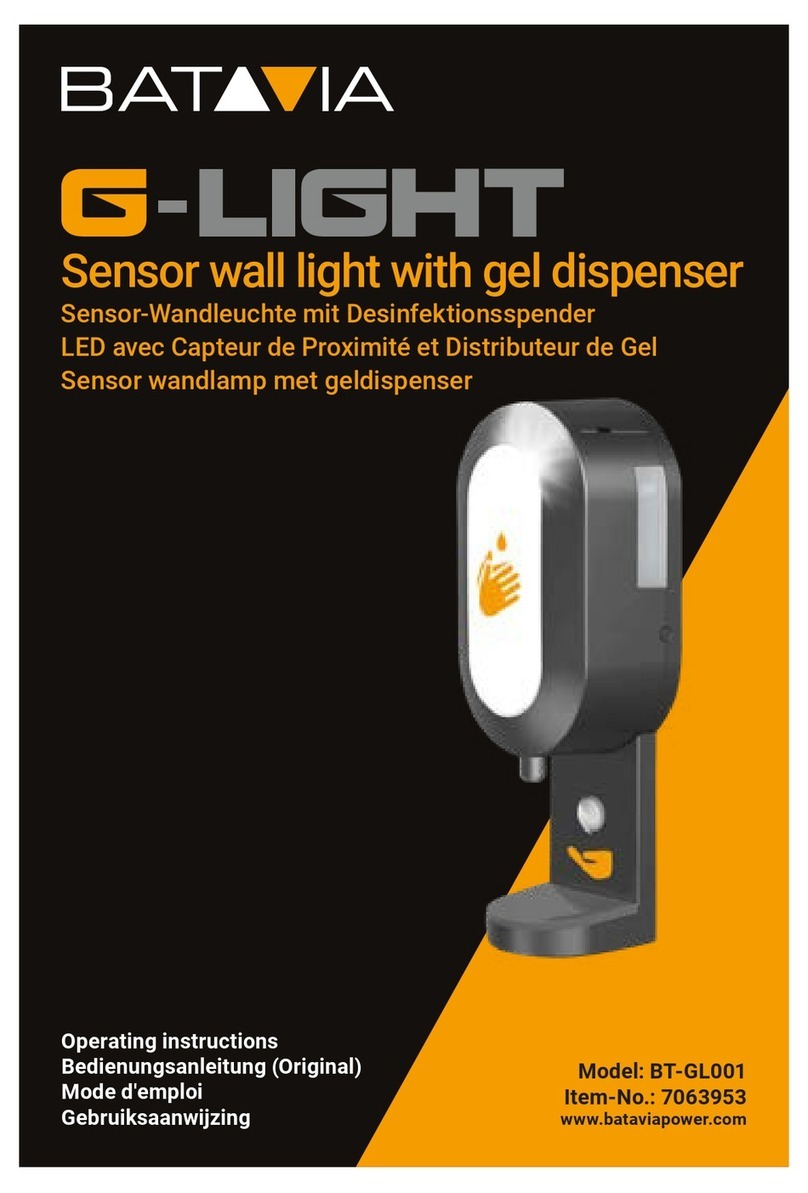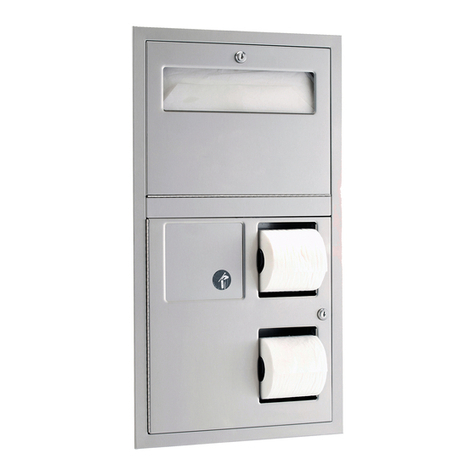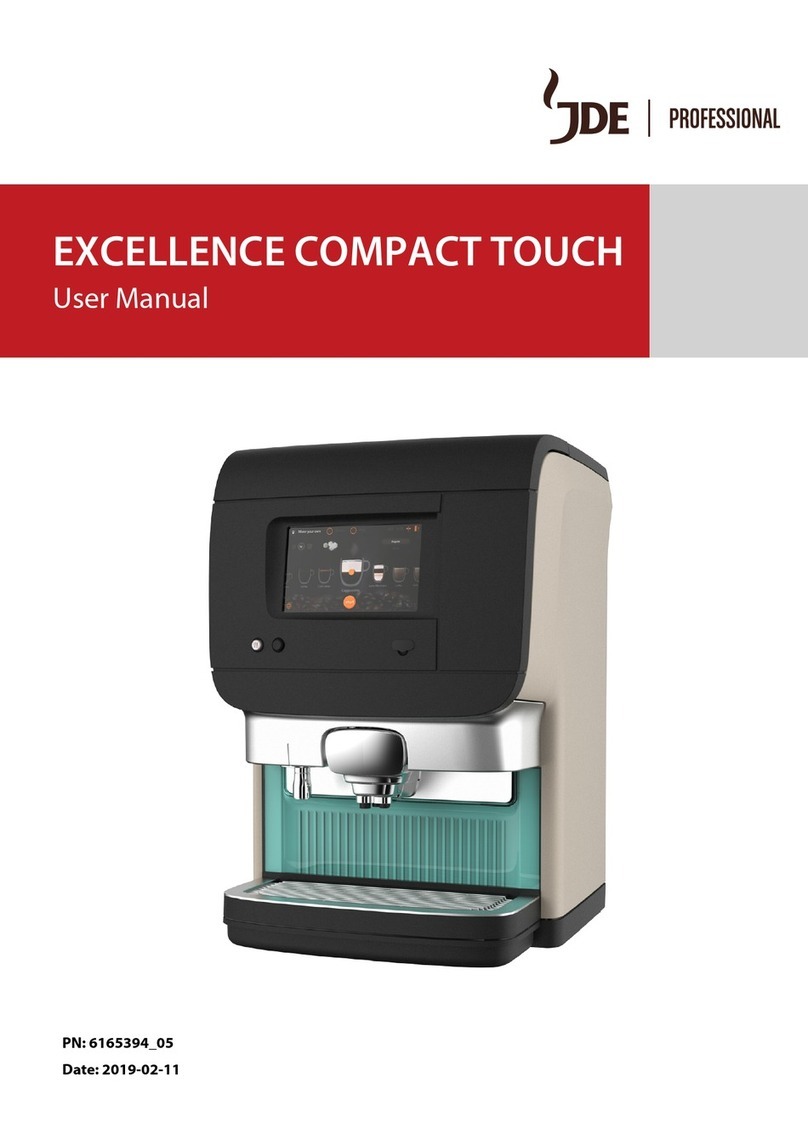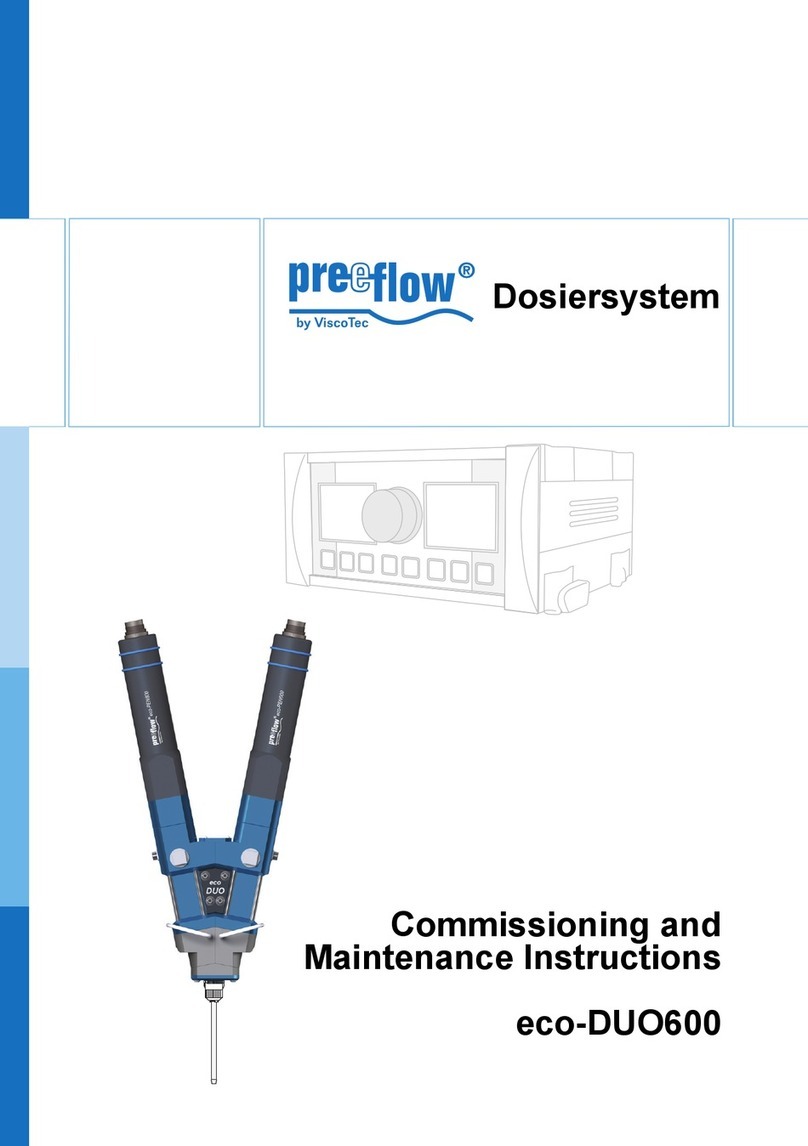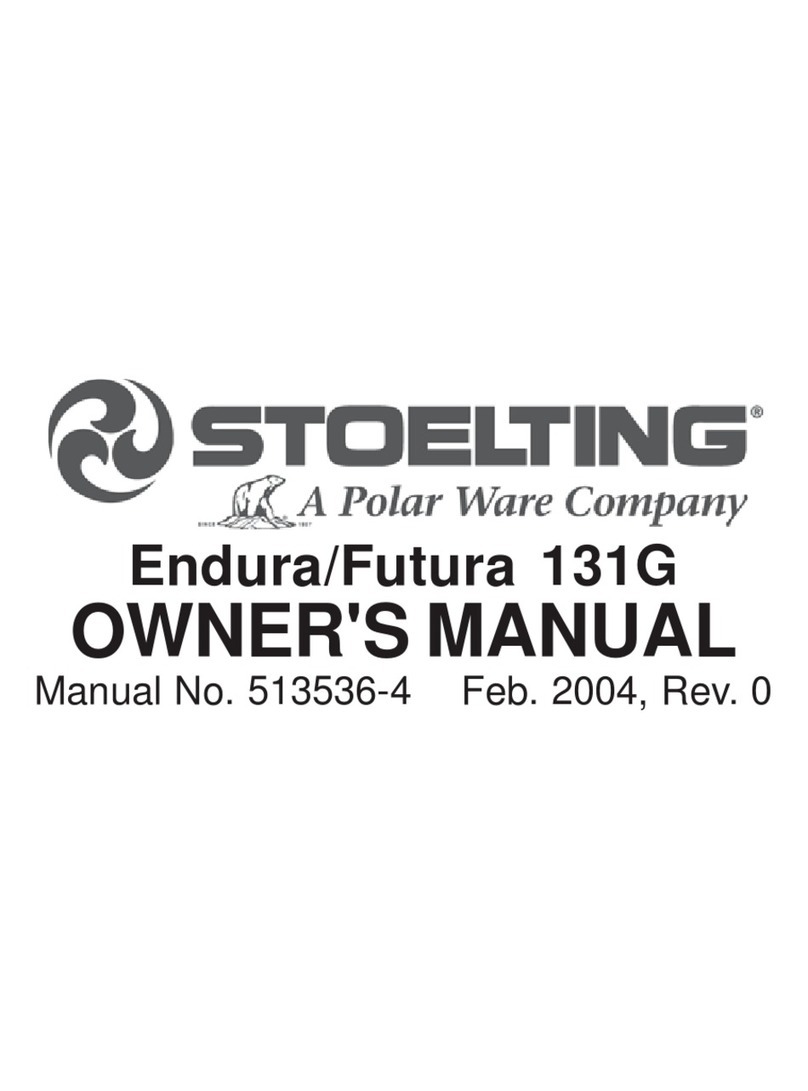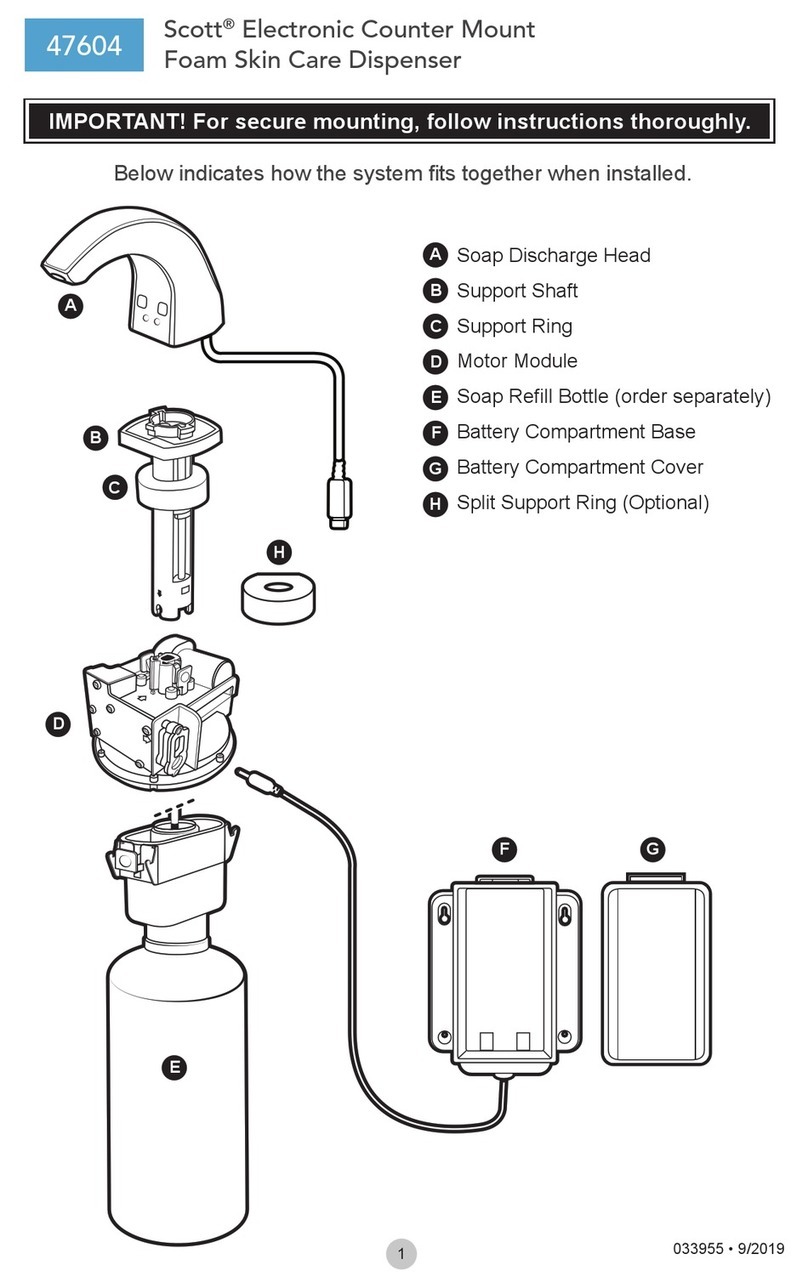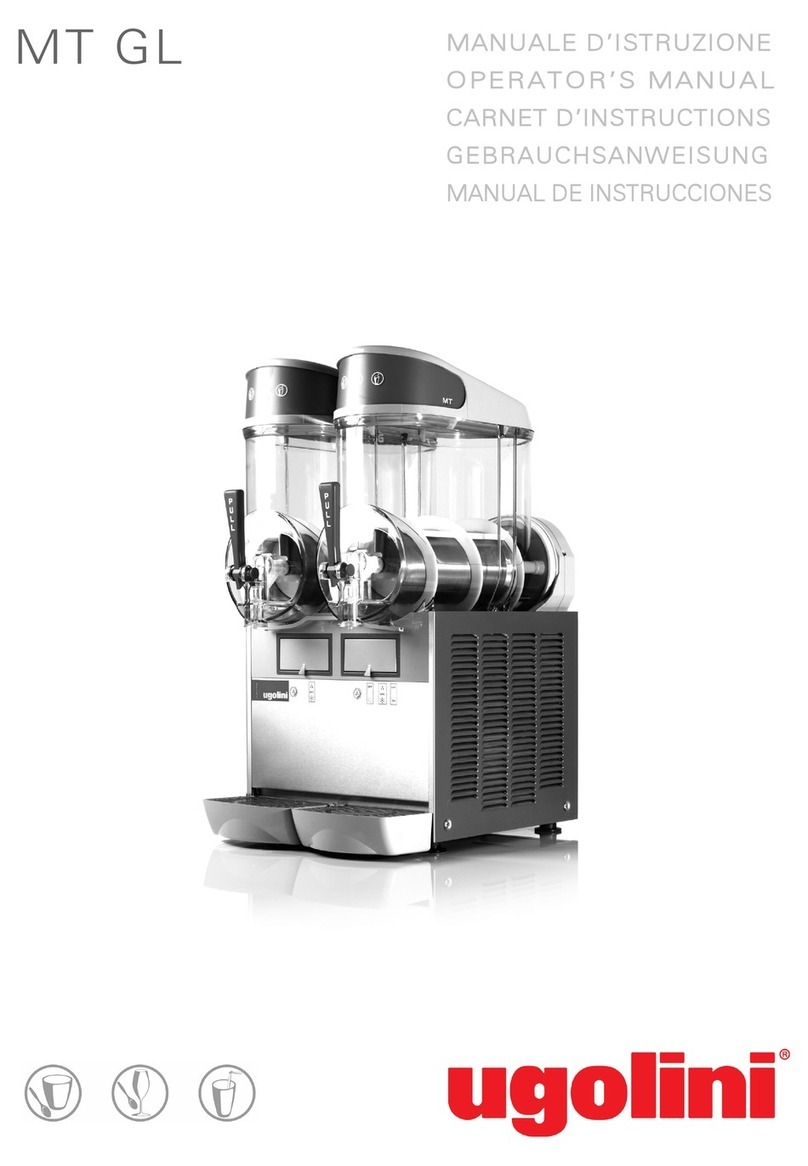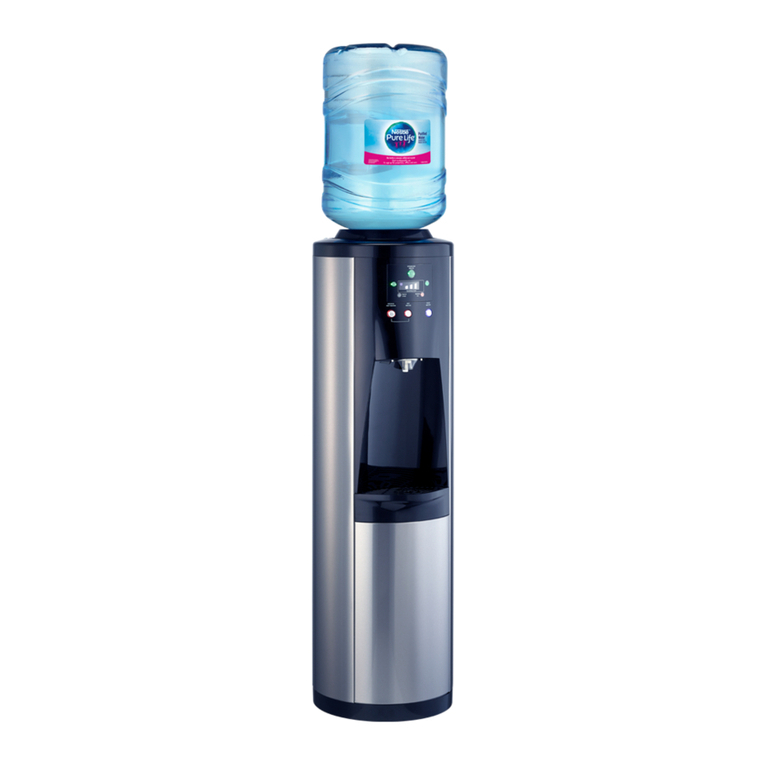FoamPRO F1000 User manual


FOAMPRO® F1000 1
©2001 R11.01
CONTENTS
Section
INSTALLATION 1.0 ................................................................................................. 2
Connecting the hose/dispenser assembly to the chemical cylinders 1.1.............2
Connecting the red "A" hose to the "A" chemical cylinder 1.2 ..............................2
Connecting the red "B" hose to the "B" chemical cylinder 1.2...............................4
Connecting the nitrogen hoses 1.3.................................................................................4
STARTUP | CALIBRATION 2.0................................................................................ 6
Startup 2.1 .............................................................................................................................6
Calibration of A:B ratio 2.2............................................................................................ 12
MAINTENANCE | SERVICE 3.0............................................................................ 22
Air Injection System 3.1.................................................................................................. 22
Trigger (D300) 3.1.1.......................................................................................................... 24
Handle (D201) 3.1.2.......................................................................................................... 24
Air Cylinder/ Piston Assembly (D300) 3.1.3............................................................... 26
Carrier Assembly (D500) 3.2.1....................................................................................... 40
Chemical Valve Service (D503R & D503B) 3.2.2...................................................... 40
Filter Screen Service (D504) 3.2.3 ................................................................................ 42
Check Valve Service 3.2.4 ...............................................................................................44
Mix Cartridge Service (D603 or Optional Cartridge) 3.2.5....................................46
Mix Cartridge Removal and Cleaning (D603 or Optional Cartridge) 3.2.6....... 48
SHUTDOWN 4.0 ................................................................................................... 52
Shutdown Procedure 4.1................................................................................................. 52
TROUBLESHOOTING 5.0 ...................................................................................... 54
PARTS LIST 6.0 .....................................................................................................55

FOAMPRO® F1000
2©2001 R11.01
INSTALLATION
Usually the Foampro dispenser is shipped to customers with the hose assembly
already connected to the dispenser. If your Foampro dispenser is not connected to
the hose assembly:
Attach the red “A” hose to the Hose Connection Fitting (D507) on the left side
of the dispenser, just behind the red valve. (See diagram 3A)(See diagram 3A)
(See diagram 3A)(See diagram 3A)
(See diagram 3A)
Attach the blue “B” hose to the Hose Connection Fitting (D507) on the right
side of the dispenser, just behind the blue valve. (See diagram 3A)(See diagram 3A)
(See diagram 3A)(See diagram 3A)
(See diagram 3A)
Attach the gray air pressure line to the quick connect fitting at the rear of the
dispenser. (See diagram 3A)(See diagram 3A)
(See diagram 3A)(See diagram 3A)
(See diagram 3A)
Lay out the dispenser/hose assembly.
Place the cylinders of “A” chemical and “B” chemical in a position where the
hoses can be connected without strain.
Be sure all valves on both of the cylinders, and the hoses are closed
before connecting or disconnecting hoses, or removing caps or
plugs from cylinder.
After checking to be sure all valves on the cylinder are closed, remove the
cap from the outlet of the chemical valve. (See diagram 3B)(See diagram 3B)
(See diagram 3B)(See diagram 3B)
(See diagram 3B) Keep the cap
handy so that it can refitted to the cylinder after the cylinder is empty.
Remove the plug from the filter end of the red "A" hose (See diagram 3B)(See diagram 3B)
(See diagram 3B)(See diagram 3B)
(See diagram 3B).
Keep the plug handy- it will be needed to reseal the hose after the hose
is disconnected from the cylinder.
Connect the red "A" hose to the outlet of the chemical valve on the
"A" component cylinder.
CAUTION:CAUTION:
CAUTION:CAUTION:
CAUTION:
Connecting the redConnecting the red
Connecting the redConnecting the red
Connecting the red
"A" hose to the "A""A" hose to the "A"
"A" hose to the "A""A" hose to the "A"
"A" hose to the "A"
chemical cylinder:chemical cylinder:
chemical cylinder:chemical cylinder:
chemical cylinder:
Connecting theConnecting the
Connecting theConnecting the
Connecting the
hose/dispenserhose/dispenser
hose/dispenserhose/dispenser
hose/dispenser
assembly to theassembly to the
assembly to theassembly to the
assembly to the
chemical cylinders:chemical cylinders:
chemical cylinders:chemical cylinders:
chemical cylinders:
1.0
1.1
1.2

FOAMPRO® F1000 3
©2001 R11.01
INSTALLATION
1.2
Nitrogen
Supply
Hose Nitrogen
Valve
Pressure
Relief
Valve
Cylinder
Chemical
Valve
Hose Filter
Chemical
Valve
Cylinder Valves - 17 Gal.
Closed
Open
Chemical
Valve
Positions:
Diagram 3A
Diagram 3B

FOAMPRO® F1000
4©2001 R11.01
To connect the blue "B" hose to the "B" chemical cylinder: After checking to
be sure that all valves on the cylinder are closed, remove the plug from the
outlet of the chemical valve (See diagram 5A).(See diagram 5A).
(See diagram 5A).(See diagram 5A).
(See diagram 5A). Keep the plug handy so that
it can be refitted to the cylinder after the cylinder is empty.
Remove the cap from the filter end of the blue "B" hose. Keep the plug handy it
will be needed to reseal the hose after the hose is disconnected from the
cylinder.
Connect the blue "B" hose to the outlet of the chemical valve on the "B" chemi-
cal cylinder.
Connect the dispenser air line to an air regulator 100 to 125 psi with moisture
separator and filter.
Compressed air that contains high levels of water or oil can adversely
affect the performance and service life of some of the parts of the
Foampro dispenser. This is particularly important when using portable
compressors. Be sure to drain the compressor of any water prior to use.
Also, it is recommended that an in line air filter and moisture separator are
used to remove oil from the compressed air source.
Place the nitrogen cylinder near the chemical cylinders, being sure to secure the
nitrogen cylinder so that it cannot be accidentally knocked over.
Connect the nitrogen regulator to the nitrogen cylinder using the threaded
pressure fitting on the rear of the nitrogen regulator assembly.
(See diagram 5B)(See diagram 5B)
(See diagram 5B)(See diagram 5B)
(See diagram 5B)
Connect the red hose leading from the nitrogen regulator assembly to the
nitrogen fitting on the "A" chemical cylinder . It will be fitted with a quick
connect fitting that will simply snap into place. (See diagram 3B, previous(See diagram 3B, previous
(See diagram 3B, previous(See diagram 3B, previous
(See diagram 3B, previous
page)page)
page)page)
page)
Connect the blue hose leading from the nitrogen regulator assembly to the
nitrogen fitting on the "B" chemical cylinder. It will be fitted with a quick
connect fitting that will simply snap into place. (See diagram 5A)(See diagram 5A)
(See diagram 5A)(See diagram 5A)
(See diagram 5A)
NONO
NONO
NOTE:TE:
TE:TE:
TE:
Connecting theConnecting the
Connecting theConnecting the
Connecting the
nitrogen hoses:nitrogen hoses:
nitrogen hoses:nitrogen hoses:
nitrogen hoses:
1.3
INSTALLATION
1.2Connecting the blueConnecting the blue
Connecting the blueConnecting the blue
Connecting the blue
"B" hose to the "B""B" hose to the "B"
"B" hose to the "B""B" hose to the "B"
"B" hose to the "B"
chemical cylinder:chemical cylinder:
chemical cylinder:chemical cylinder:
chemical cylinder:

FOAMPRO® F1000 5
©2001 R11.01
INSTALLATION
1.3
Nitrogen
Supply
Hose
Nitrogen
Valve
Pressure
Relief
Valve
Cylinder
Chemical
Valve
Hose Filter
Chemical
Valve
Cylinder Valves - 60 Gal.
Closed
Open
Chemical
Valve
Positions:
Chemical
Filter
Diagram 5A
Diagram 5B

FOAMPRO® F1000
6©2001 R11.01
STARTUP | CALIBRATION
2.0 Make sure all installation steps have been completed prior to startup and calibra-
tion. Make sure that the chemicals are at the correct operating temperature, usually
70° to 90° F.
1| Be sure that all valves are closed. (See diagrams for valve locations)(See diagrams for valve locations)
(See diagrams for valve locations)(See diagrams for valve locations)
(See diagrams for valve locations) This
would include: The valve on top of the nitrogen cylinder. The nitrogen valve on
top of both chemical cylinders ("A" Chemical and "B" Chemical). (See dia-(See dia-
(See dia-(See dia-
(See dia-
grams 6A & 7A)grams 6A & 7A)
grams 6A & 7A)grams 6A & 7A)
grams 6A & 7A) The chemical outlet valve on top of both chemical cylinders
("A" chemical and "B" chemical) (See diagrams 6A & 7A)(See diagrams 6A & 7A)
(See diagrams 6A & 7A)(See diagrams 6A & 7A)
(See diagrams 6A & 7A) The chemical valve
on the filter end of both the red "A" component hose and the blue "B" compo-
nent hose. (See diagram 6A & 7A)(See diagram 6A & 7A)
(See diagram 6A & 7A)(See diagram 6A & 7A)
(See diagram 6A & 7A) Both the red chemical valve and the blue
chemical valve on the F1000 dispenser (See diagram 7B).(See diagram 7B).
(See diagram 7B).(See diagram 7B).
(See diagram 7B).
Startup:Startup:
Startup:Startup:
Startup:
2.1
Nitrogen
Supply
Hose Nitrogen
Valve
Pressure
Relief
Valve
Cylinder
Chemical
Valve
Hose Filter
Chemical
Valve
Cylinder Valves - 17 Gal.
Closed
Open
Chemical
Valve
Positions:
Diagram 6A

FOAMPRO® F1000 7
©2001 R11.01
STARTUP | CALIBRATION
2.1
Nitrogen
Supply
Hose
Nitrogen
Valve
Pressure
Relief
Valve
Cylinder
Chemical
Valve
Hose Filter
Chemical
Valve
Cylinder Valves - 60 Gal.
Closed
Open
Chemical
Valve
Positions:
Chemical
Filter
Diagram 7A
Diagram 7B

FOAMPRO® F1000
8©2001 R11.01
2| Turn on the air supply to the dispenser, and check for leaks.
3 | Remove Mix Cartridge Plug (D620) if one is in place..
..
.Do not install nozzle
until calibration steps are completed.
4 | Open both of the air injection valves (D704, D705) (See diagram 9A)(See diagram 9A)
(See diagram 9A)(See diagram 9A)
(See diagram 9A) to see
if the air passes freely through the dispenser. Re-close both of the air injection
valves, as they must be closed to complete the calibration of the dispenser.
5 | Turn the adjustment valves on both nitrogen regulators leading to the "A"
chemical and the "B" chemical counterclockwise two full turns. (See diagram(See diagram
(See diagram(See diagram
(See diagram
9B)9B)
9B)9B)
9B)
6 | Open the valve on top of the nitrogen cylinder, and check for leaks.
7 | Adjust the "A" component nitrogen regulator (one with the red hose) to 190
psi (starting point) by turning clockwise (See diagram 9B)(See diagram 9B)
(See diagram 9B)(See diagram 9B)
(See diagram 9B)
8 | Adjust the "B" component nitrogen regulator (one with the blue hose) to
140 psi (starting point) by turning clockwise (See diagram 9B)(See diagram 9B)
(See diagram 9B)(See diagram 9B)
(See diagram 9B)
The chemical cylinders are equipped with a pressure overload relief valve
that will open if the pressure of the cylinder exceeds approximately 220
psi. Do not adjust nitrogen pressure on the chemical cylinders to approach
220 psi.
NONO
NONO
NOTE:TE:
TE:TE:
TE:
STARTUP | CALIBRATION
2.1

FOAMPRO® F1000 9
©2001 R11.01
STARTUP | CALIBRATION
2.1
Diagram 9A
Diagram 9B

FOAMPRO® F1000
10 ©2001 R11.01
STARTUP | CALIBRATION
2.1 9| Open the nitrogen valves on both chemical cylinders ( "A" component and
"B" component). (See diagram 1(See diagram 1
(See diagram 1(See diagram 1
(See diagram 11A & 11A & 1
1A & 11A & 1
1A & 11B)1B)
1B)1B)
1B)
10 | Open the chemical valves on both chemical cylinders ( "A" component and
"B" component). (See diagram 1(See diagram 1
(See diagram 1(See diagram 1
(See diagram 11A & 11A & 1
1A & 11A & 1
1A & 11B)1B)
1B)1B)
1B) Check for leaks. Tighten any leaking
fittings.
11 | Open the chemical valves on the filter end of the hose assembly for both
the "A" component and "B" component. (See diagram 1(See diagram 1
(See diagram 1(See diagram 1
(See diagram 11A & 11A & 1
1A & 11A & 1
1A & 11B)1B)
1B)1B)
1B) Check for
leaks. Tighten any leaking fittings.
12 | Position a garbage can with a plastic liner at the work area.
13 | Make sure mixing cartridge plug is removed.
14 | Open the red valve and the blue valve on the F1000 dispenser.
(See diagram 1(See diagram 1
(See diagram 1(See diagram 1
(See diagram 10A)0A)
0A)0A)
0A)
15 | While aiming the F1000 into the trash can, pull the trigger on the F1000
dispenser for 10 seconds, dispensing the foam into the trash can liner. If your
F1000 is brand new, you may have to pull the trigger for a longer period to
purge the air out of the hoses. If your F1000 dispenser was put into storage
with the hoses full of chemicals, you may have to dispense foam for longer than
10 seconds to be sure that the chemicals that were stored in the hoses is fully
flushed out by fresh chemicals from the chemical cylinders.
Diagram 10A

FOAMPRO® F1000 11
©2001 R11.01
STARTUP | CALIBRATION
2.2
Nitrogen
Supply
Hose
Nitrogen
Valve
Pressure
Relief
Valve
Cylinder
Chemical
Valve
Hose Filter
Chemical
Valve
Cylinder Valves - 60 Gal.
Closed
Open
Chemical
Valve
Positions:
Chemical
Filter
Nitrogen
Supply
Hose Nitrogen
Valve
Pressure
Relief
Valve
Cylinder
Chemical
Valve
Hose Filter
Chemical
Valve
Cylinder Valves - 17 Gal.
Closed
Open
Chemical
Valve
Positions:
Diagram 11A
Diagram 11B

FOAMPRO® F1000
12 ©2001 R11.01
Proper mixing of the “A” and “B” component chemicals in the correct propor-
tions is important in producing foam. Foams produced with an improper propor-
tion of “A” to “B” chemical can in some cases affect foam properties.
When and how often should the A:B ratio be checked?
•At the beginning of the workday.
•When a new cylinder of “A” or “B” component is installed.
•When a new cylinder of nitrogen is installed.
•About halfway through the normal workday.
•When the temperature in the work area increases or decreases by more
than 10 degrees. If the temperature of the chemicals changes, the viscosity
of the chemicals changes. This viscosity change can have an effect on the
A:B ratio.
•If a noticable change takes place in the foam being produced.
•After any restriction in the chemical flow is removed, for example cleaning
the filters or the ports in the mixing cartridge in the F1000 will likely
increase the flow of chemical which in turn may change the A:B ratio.
•When a new mixing cartridge is installed.
1| Make sure that the F1000 dispenser is correctly installed to the chemical
cylinders, nitrogen cylinders, and compressed air supply as described in the
Startup procedures above. Check all hose connections to be sure that there are
no leaks. Make sure the air injection on/off valve is closed. For calibration,
remove the plastic nozzle. (See diagram 13A)(See diagram 13A)
(See diagram 13A)(See diagram 13A)
(See diagram 13A)
2| Place a 32oz paper cup on a scale, and tare the scale to read zero.
3| Open the "A" (red) chemical valve and close the "B" chemical (blue) valve on
the F1000 dispenser. (See diagram 13B)(See diagram 13B)
(See diagram 13B)(See diagram 13B)
(See diagram 13B)
4| Using a stop watch, or optional timer, trigger the F1000 dispenser for exactly
3 seconds, directing the flow of the "A" chemical into the paper cup on the
scale. Record the weight of "A" chemical dispensed.
5| Critical Step- Purging the mix cartridge: After measuring the weight of
the dispensed "A" chemical in step 4, open the both "B" chemical (blue) valve
and the "A" chemical (red) valve on the F1000 dispenser. (See diagram 13B)(See diagram 13B)
(See diagram 13B)(See diagram 13B)
(See diagram 13B)
Then, while directing the flow of the dispenser into a trash can, trigger the
F1000 dispenser for a few seconds to dispense a mixture of "A" and "B" chemi-
cals into the trash can. This step is important because it will reduce plugging of
the mix cartridge.
Calibration ofCalibration of
Calibration ofCalibration of
Calibration of
A:B ratio:A:B ratio:
A:B ratio:A:B ratio:
A:B ratio:
STARTUP | CALIBRATION
2.2

FOAMPRO® F1000 13
©2001 R11.01
STARTUP | CALIBRATION
2.2
Diagram 13B
Diagram 13A

FOAMPRO® F1000
14 ©2001 R11.01
6| Close the "A" chemical (red) valve on the F1000 dispenser, leaving the "B"
chemical (blue) valve open. (See diagram 15A)(See diagram 15A)
(See diagram 15A)(See diagram 15A)
(See diagram 15A)
7| Place a 32 oz. paper cup on a scale, and tare the scale to read zero.
8| Using a stop watch, or optional timer, trigger the F1000 dispenser for exactly
3 seconds, directing the flow of the "B" chemical into the paper cup on the
scale. Record the weight of "B" chemical dispensed.
9| Purge the mix cartridge once again as outlined in step 5 above.
10 | Calculate the A:B chemical ratio by dividing the weight of the "A" chemical
obtained from step 4 by the weight of the "B" chemical obtained in step 8.
Example:
"A" chemical (3 second shot) weighs 41 grams
"B" chemical (3 second shot) weighs 37 grams
41 grams ÷ 37 grams = 1.11 A:B ratio
Most Polypro formulations should be run with an A:B ratio in the range of 1.00
to 1.15. Consult the technical data sheet for the Polypro formulation you are
running- it will list the best A:B ratio for that particular product (See Ratio
Calibration Charts on pages 18 - 21).
11 | If the A:B chemical ratio obtained in step 10 is too high, ie above 1.15,
adjust the nitrogen pressure on the "B" chemical up by 10 psi and repeat the
calibration procedure starting at step 1. If the A:B ratio obtained in step 10 was
too low, ie below 1.00, the adjust the nitrogen pressure on the "A" chemical up
by 10 psi and repeat the calibration procedure. It may be necessary make more
than one adjustment to the nitrogen pressure of the "B" chemical before reach-
ing the correct A:B ratio. It is advisable to adjust the nitrogen pressure on the
B" component in order to adjust the A:B ratio, not the nitrogen pressure on the
"A" chemical.
12 | It may be necessary during the calibration process to reduce the nitrogen
pressure on one of the chemical cylinders. This situation occurs when the proper
A:B component ratio cannot be achieved without raising the pressure on one of
the cylinders to its maximum pressure of 220 psi. REMEMBER: Each of the
chemical cylinders is equipped with a pressure relief valve that will auto-
matically open if the nitrogen pressure on the cylinder exceeds 220 psi.
Use the following steps to reduce nitrogen pressure on the cylinder. SAFETY
GLASSES SHOULD BE WORN DURING THIS PROCEDURE.
STARTUP | CALIBRATION
2.2

FOAMPRO® F1000 15
©2001 R11.01
STARTUP | CALIBRATION
2.2
Diagram 15A

FOAMPRO® F1000
16 ©2001 R11.01
STARTUP | CALIBRATION
2.2
NONO
NONO
NOTE:TE:
TE:TE:
TE:
1 - Close nitrogen valve on the chemical cylinder. (See diagrams 16A & 16B)(See diagrams 16A & 16B)
(See diagrams 16A & 16B)(See diagrams 16A & 16B)
(See diagrams 16A & 16B)
2 - Using the nitrogen pressure adjustment valve for the chemical cylinder
being adjusted, turn the adjustment valve counterclockwise two full turns.
(See diagram 17A)(See diagram 17A)
(See diagram 17A)(See diagram 17A)
(See diagram 17A)
3 - Locate the pressure relief valve on the chemical cylinder being adjusted.
(See diagrams 16A & 16B)(See diagrams 16A & 16B)
(See diagrams 16A & 16B)(See diagrams 16A & 16B)
(See diagrams 16A & 16B)
4 - Pull upward on the ring of the pressure relief valve for 2 or 3 seconds, then
release the ring to allow the valve to close. A burst of pressure will escape from
the valve.
5 - Open the nitrogen valve on the chemical cylinder. (See diagrams 16A &(See diagrams 16A &
(See diagrams 16A &(See diagrams 16A &
(See diagrams 16A &
16B)16B)
16B)16B)
16B)
6 - Using the nitrogen pressure adjustment valve for the chemical cylinder
being adjusted, turn the valve clockwise to the desired pressure.
(See diagram 17A)(See diagram 17A)
(See diagram 17A)(See diagram 17A)
(See diagram 17A)
Following these steps should result in a decrease in the pressure on the chemi-
cal cylinder.
The chemical cylinders are equipped with a pressure overload relief valve
that will open if the pressure of the cylinder exceeds approximately 220
psi. Do not adjust nitrogen pressure on the cylinders to approach 220 psi.
Before using the F1000 dispenser, you will need to install the plastic nozzle onto
the Mix Cartridge. The valves on the Air Injection System will have to be opened so
that air is passing freely.
The Air Injection System is comprised of two valves, an On/Off Valve (D704) and a
Needle Valve (D703) that are connected to the F1000 by a series of simple 1/8”
fittings. (See Diagram 17B) The Air Injection System serves three purposes. The air
flowing into the Mix Cartridge (D603) helps:
• the mixing of the “A” and “B” chemicals
• propel the chemicals out of the nozzle,
• keep the Mix Cartridge (D603) clear of curing foam.
The Needle Valve (D703) can be adjusted by turning the knob to control the amount
Nitrogen
Supply
Hose Nitrogen
Valve
Pressure
Relief
Valve
Cylinder
Chemical
Valve
Hose Filter
Chemical
Valve
Cylinder Valves - 17 Gal.
Closed
Open
Chemical
Valve
Positions:
Nitrogen
Supply
Hose
Nitrogen
Valve
Pressure
Relief
Valve
Cylinder
Chemical
Valve
Hose Filter
Chemical
Valve
Cylinder Valves - 60 Gal.
Closed
Open
Chemical
Valve
Positions:
Chemical
Filter
Diagram 16A
Diagram 16B
(Left)
(Right)

FOAMPRO® F1000 17
©2001 R11.01
STARTUP | CALIBRATION
2.2
of air flowing through the system. Different uses of the F1000, for example spraying
foam, may require a higher flow of air than pouring foam. Experience in using the
F1000 will help the user determine what air flow level suits their needs.
Once the proper amount of airflow through the Air Injection System has been
achieved, the F1000 dispenser is ready for use. Foam product can be dispensed by
depressing the trigger.
After using the F1000 dispenser, if it is to momentarily sit idle for more than a few
minutes, either let air flow through the Air Injection System, or place a few drops of
solvent into the open end of the plastic nozzle. Keep the plastic nozzle pointed
upward so the solvent remains and prevents any foam product from curing in the
end of the nozzle or mix cartridge. If the F1000 dispenser is to be shut down or
stored for a long period of time, follow the procedure for Shutdown described in
Section 4.1.
Diagram 17A
Diagram 17B

FOAMPRO® F1000
18 ©2001 R11.01
Three second shot of "A" Three second shot of "B" Approximate Total Output
Grams of "A" Component FROM - Grams of "B" component - TO in Pounds per minute
30 26.1 28.6 2.5
31 27.0 29.5 2.6
32 27.8 30.5 2.7
33 28.7 31.4 2.8
34 29.6 32.4 2.9
35 30.4 33.3 2.9
36 31.3 34.3 3.0
37 32.2 35.2 3.1
38 33.0 36.2 3.2
39 33.9 37.1 3.3
40 34.8 38.1 3.4
41 35.7 39.0 3.4
42 36.5 40.0 3.5
43 37.4 41.0 3.6
44 38.3 41.9 3.7
45 39.1 42.9 3.8
46 40.0 43.8 3.9
47 40.9 44.8 4.0
48 41.7 45.7 4.0
49 42.6 46.7 4.1
50 43.5 47.6 4.2
51 44.3 48.6 4.3
52 45.2 49.5 4.4
53 46.1 50.5 4.5
54 47.0 51.4 4.5
55 47.8 52.4 4.6
56 48.7 53.3 4.7
57 49.6 54.3 4.8
58 50.4 55.2 4.9
59 51.3 56.2 5.0
60 52.2 57.1 5.0
61 53.0 58.1 5.1
62 53.9 59.0 5.2
63 54.8 60.0 5.3
64 55.7 61.0 5.4
65 56.5 61.9 5.5
66 57.4 62.9 5.6
67 58.3 63.8 5.6
68 59.1 64.8 5.7
69 60.0 65.7 5.8
70 60.9 66.7 5.9
STARTUP | CALIBRATION
2.2

FOAMPRO® F1000 19
©2001 R11.01
Three second shot of "A" Three second shot of "B" Approximate Total Output
Grams of "A" Component FROM - Grams of "B" component - TO in Pounds per minute
71 61.7 67.6 6.0
72 62.6 68.6 6.1
73 63.5 69.5 6.1
74 64.3 70.5 6.2
75 65.2 71.4 6.3
76 66.1 72.4 6.4
77 67.0 73.3 6.5
78 67.8 74.3 6.6
79 68.7 75.2 6.6
80 69.6 76.2 6.7
81 70.4 77.1 6.8
82 71.3 78.1 6.9
83 72.2 79.0 7.0
84 73.0 80.0 7.1
85 73.9 81.0 7.1
86 74.8 81.9 7.2
87 75.7 82.9 7.3
88 76.5 83.8 7.4
89 77.4 84.8 7.5
90 78.3 85.7 7.6
91 79.1 86.7 7.7
92 80.0 87.6 7.7
93 80.9 88.6 7.8
94 81.7 89.5 7.9
95 82.6 90.5 8.0
96 83.5 91.4 8.1
97 84.3 92.4 8.2
98 85.2 93.3 8.2
99 86.1 94.3 8.3
100 87.0 95.2 8.4
101 87.8 96.2 8.5
102 88.7 97.1 8.6
103 89.6 98.1 8.7
104 90.4 99.0 8.7
105 91.3 100.0 8.8
106 92.2 101.0 8.9
107 93.0 101.9 9.0
108 93.9 102.9 9.1
109 94.8 103.8 9.2
110 95.7 104.8 9.3
111 96.5 105.7 9.3
STARTUP | CALIBRATION
2.2
Table of contents
Popular Dispenser manuals by other brands

Georgia Pacific
Georgia Pacific GP PRO Pacific Blue Ultra 56602A reference guide
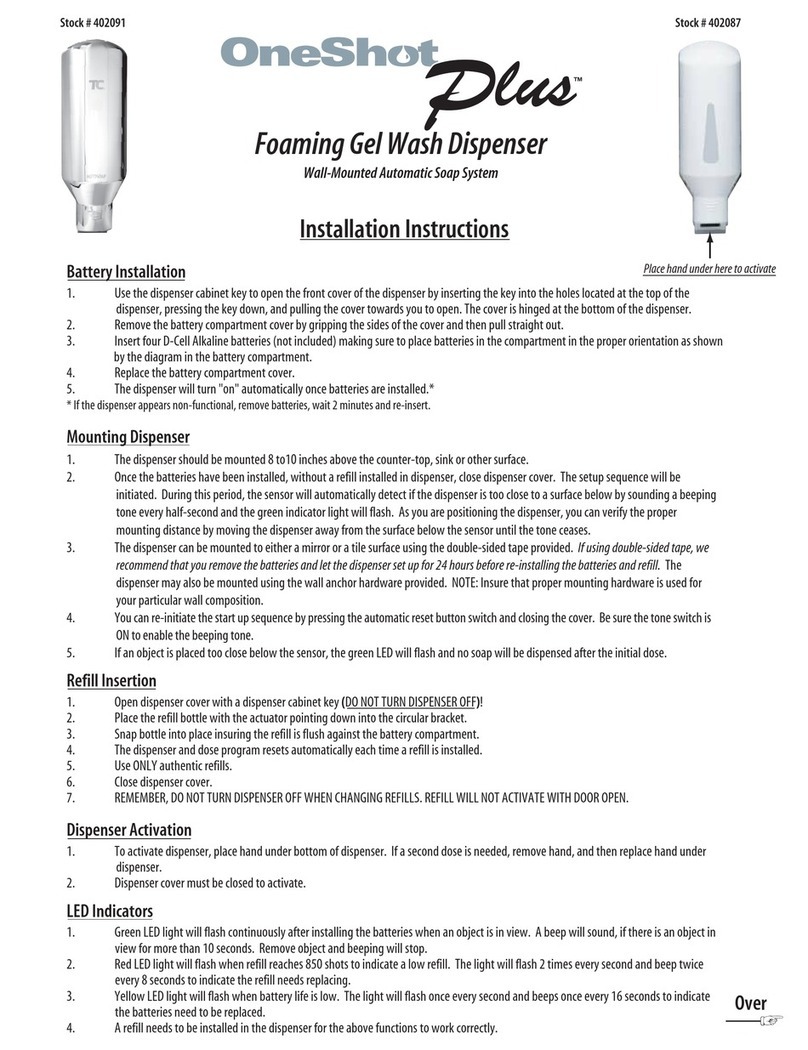
Technical Concepts
Technical Concepts OneShot Plus installation instructions
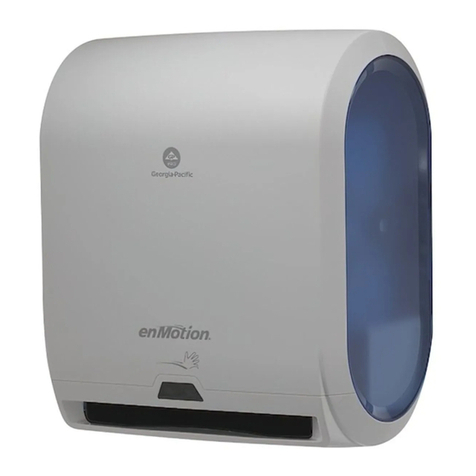
Georgia Pacific
Georgia Pacific enMotion 10 reference guide
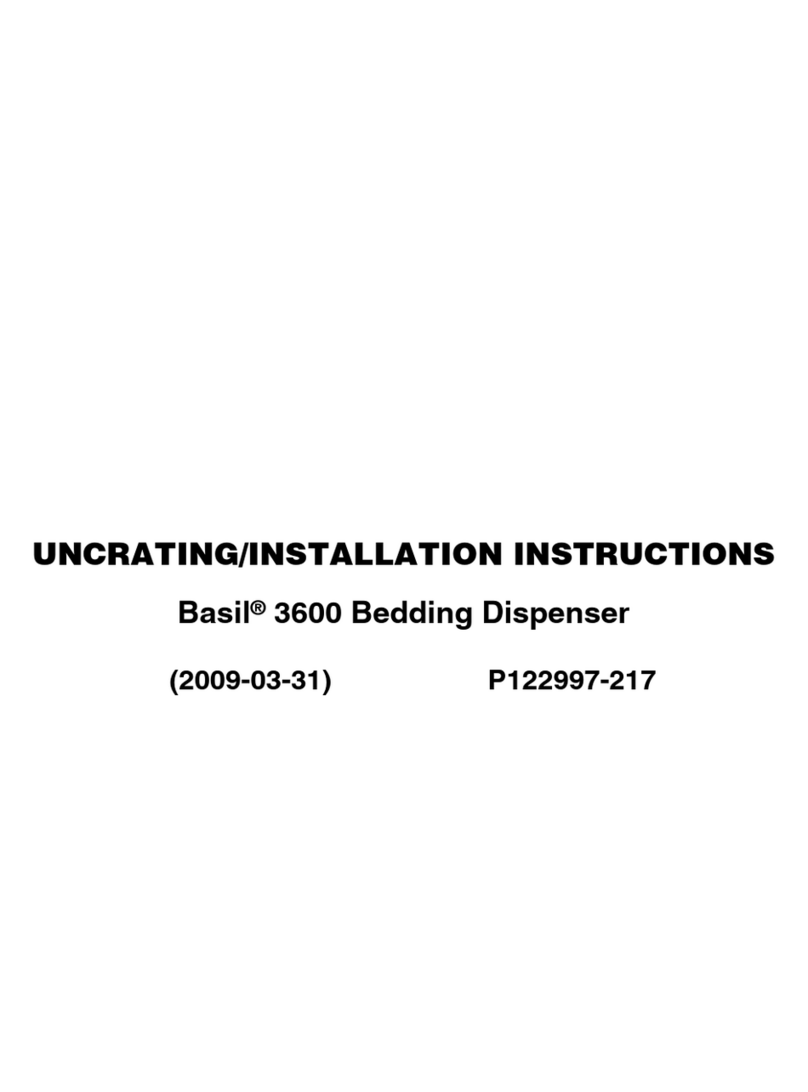
Steris
Steris Basil 3600 installation instructions

Bunn
Bunn JDF-2S Service & repair manual
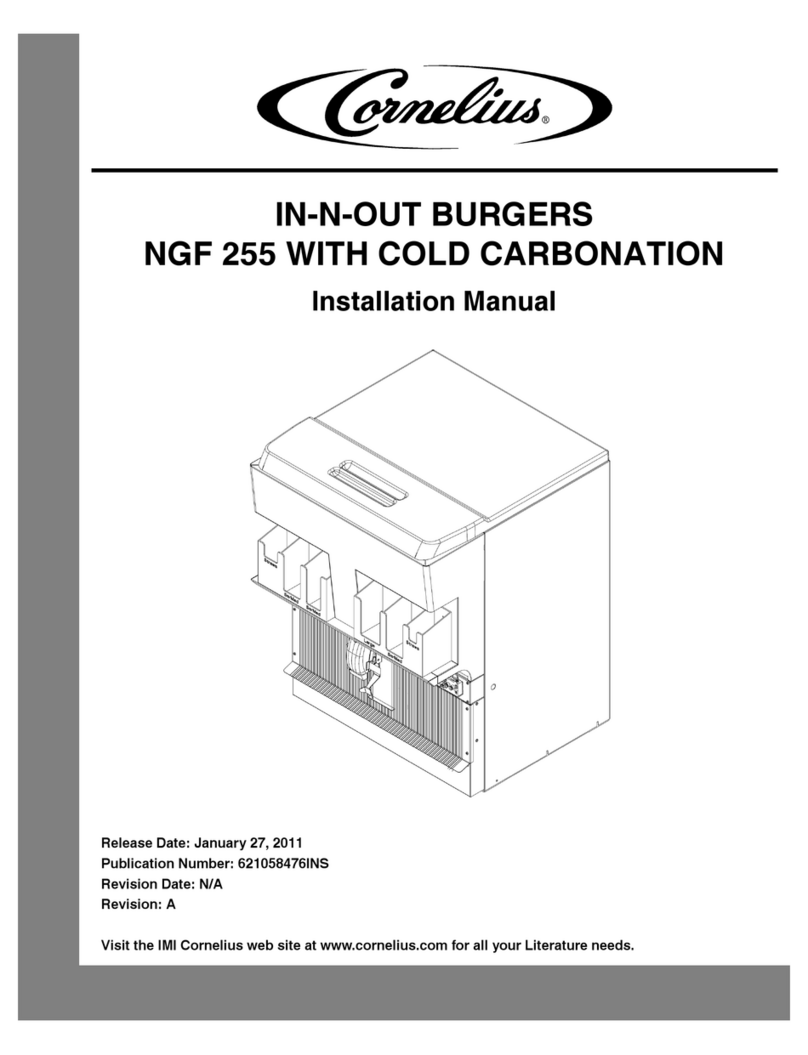
Cornelius
Cornelius In-N-Out Burger NGF 255 installation manual
